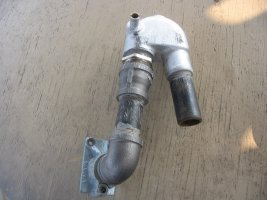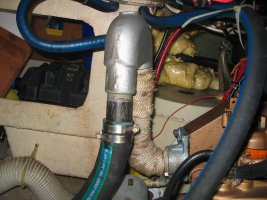Bolo
Contributing Partner
I have an E-32 III with a Universal M-25XP engine. The original exhaust elbow riser started showing rust spots on either side of the elbow indicating that it was failing. The metal was rusting out at both spots so I figured it was time to replace the unit. I contacted Torrensen Marine, via email, sending them the details on the engine and even a digital photo of the failing elbow.
They recommended and sent me a replacement elbow (with a Westerbeke name on it) flange (to connect it to the exhaust port on the engine) and other parts to make it all work. It went on the engine without a hitch. A perfect fit up until I got to connecting it to the muffler. It seems that the "old" Universal elbow had a 1 5/8" fitting but the new Westerbeke replacement has a 2" fitting. So I couldn't connect it to the muffler which has a 1 5/8" fitting. I tried to find an adapter, 2" to 1 5/8", so I could make the connection, but no one in the Annapolis, Md area had one which surprised me.
I tired a couple of variations of brass fittings to go from 2" to 1 5/8" but adding all those reducers and fittings just made the whole set up a nightmare and it just wouldn't fit. So then I called Torrensen Marine and told them about my problem. They suggested that I purchase a 2" to 1 5/8" reducer coupling (by Centek) which they told me was made from fiberglass and would be OK to use on the "wet" side of the exhaust system. The guys at "West Marine" also told me that a fitting made from fiberglass was OK to use. But still there is the problem of a tight fit which was a challenge with the original 1 5/8" hose but will be more so with the reducer and a 2" hose. So I was thinking of getting a length of Vetus 2" corrugated hose which is suppose to be "extremely" flexible and approved for exhaust use.
So, what I'd like to hear is if anyone else has replaced the old exhaust elbow and, if you had similar fitting problems, what did you do? Thanks in advance to you all!
They recommended and sent me a replacement elbow (with a Westerbeke name on it) flange (to connect it to the exhaust port on the engine) and other parts to make it all work. It went on the engine without a hitch. A perfect fit up until I got to connecting it to the muffler. It seems that the "old" Universal elbow had a 1 5/8" fitting but the new Westerbeke replacement has a 2" fitting. So I couldn't connect it to the muffler which has a 1 5/8" fitting. I tried to find an adapter, 2" to 1 5/8", so I could make the connection, but no one in the Annapolis, Md area had one which surprised me.
I tired a couple of variations of brass fittings to go from 2" to 1 5/8" but adding all those reducers and fittings just made the whole set up a nightmare and it just wouldn't fit. So then I called Torrensen Marine and told them about my problem. They suggested that I purchase a 2" to 1 5/8" reducer coupling (by Centek) which they told me was made from fiberglass and would be OK to use on the "wet" side of the exhaust system. The guys at "West Marine" also told me that a fitting made from fiberglass was OK to use. But still there is the problem of a tight fit which was a challenge with the original 1 5/8" hose but will be more so with the reducer and a 2" hose. So I was thinking of getting a length of Vetus 2" corrugated hose which is suppose to be "extremely" flexible and approved for exhaust use.
So, what I'd like to hear is if anyone else has replaced the old exhaust elbow and, if you had similar fitting problems, what did you do? Thanks in advance to you all!


 It is very simple, though not elegant.
It is very simple, though not elegant.
